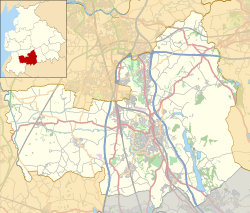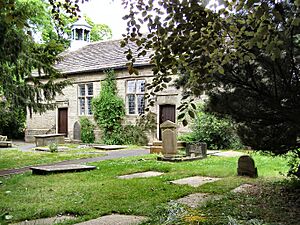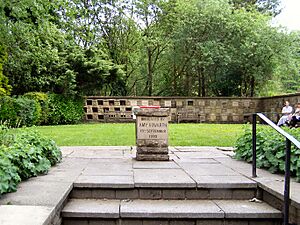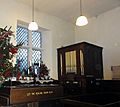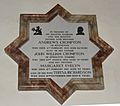Rivington Unitarian Chapel facts for kids
Quick facts for kids Rivington Unitarian Chapel |
|
|---|---|
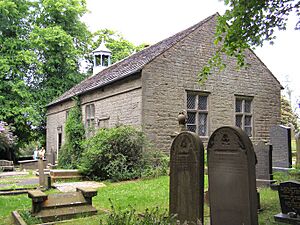
Unitarian Chapel, Rivington
|
|
| 53°37′32″N 2°33′55″W / 53.6255°N 2.5652°W | |
| Location | Rivington, Lancashire |
| Country | England |
| Denomination | Unitarian |
| History | |
| Founded | 1703 |
| Architecture | |
| Functional status | Active |
| Heritage designation | Grade II* listed building |
| Specifications | |
| Materials | local gritstone |
The Rivington Unitarian Chapel is a special church in Rivington, Lancashire, England. It's a place where people who follow Unitarian beliefs come to worship. Even though the building was built in 1703, the group of people who worshiped together started much earlier, in 1667. This chapel is considered a very important old building, called a Grade II* listed building, and it has been carefully looked after and repaired over the years, including in 1990.
Contents
Discovering the Chapel's Past
How the Chapel Began
After 1660, the Church of England became very powerful again. They made new laws to make everyone follow their rules. Many religious leaders, called Nonconformists, refused to follow these rules. Because of this, about 2,500 ministers had to leave their churches in 1662. This event is known as the Great Ejection.
One of these ministers was Samuel Newton from Rivington Church. Many people from his church followed him. They formed the first nonconformist group in Rivington. Laws were made to stop these groups from meeting. For example, the Conventicle Act of 1664 stopped religious meetings of more than five people.
Early Supporters and Ministers
People like William Anderton helped the nonconformists by leaving money in their wills. Samuel Newton was allowed to teach again in 1672. He returned to preach at Rivington Church in 1674. He passed away in 1682 and was buried at Rivington Church.
The Rev. John Walker took over after Newton. He died in 1702. The first minister of the new chapel was Rev. Ralph Ainsworth, from 1704 to 1716. More people, like Thomas Anderton, also gave money to help the nonconformists.
Building the Chapel
The chapel was built in 1703 on land given by John Andrews. He said it could only be used for Protestant religious services. The land was leased for 2,000 years for a very small payment. The chapel was built with local stone.
By 1704, the chapel had a formal trust deed. It was well-funded by 1737. The Rev. John Turner, a minister from 1716 to 1717, even helped in a battle in 1715. Between 1717 and 1729, records show that about 395 people attended services.
Changes Over Time
In 1754, the chapel changed its beliefs from Presbyterianism to Unitarianism. Around that time, the chapel was also allowed to hold weddings. In 2021, the license was updated to allow same-sex marriages.
In 1760, some people who disagreed with Unitarianism started a new Presbyterian chapel in Horwich. This split the religious community in the area.
A house for the minister, called a manse, was built in 1787. A Sunday school started in 1795 in the building next door. A library was also added by Rev James Taylor, which operated until 1985.
In 1893, some Methodists tried to hold a loud service outside the chapel to convert the Unitarian congregation. But a local person made so much noise by banging a silver tea tray that the Methodist preacher gave up!
Recent History and Preservation
The inside of the chapel was repaired in 1952 and 1960. Unitarians from all over the country visited the chapel in 1961. The old manse is now a private home. Money from its sale was used to create a garden of remembrance in 1970. This garden has walls with special spots for ashes.
After the library closed in 1985, the building became a café. It is now known as Rivington Village Green Tea Room. The chapel's roof and other parts were repaired again in 2016 to keep it in good condition.
Chapel Design and Features
Outside the Chapel
The chapel is a simple building made of local gritstone. It used to have a Thatched roof but now has a slate roof. There is a small, six-sided bell tower on one end. The bell was bought in 1876.
The side walls have two windows with rectangular glass panes. The end walls have windows with small diamond-shaped glass panes. On the south side, there are two doors. One door has the date 1703 carved above it.
Next to the chapel is a two-story building that used to be the school house. The chapel is surrounded by a drystone wall. The original bell and the cast iron gates from 1816 are still there.
Inside the Chapel
The ceiling inside the chapel is held up by strong oak beams. The walls are painted simply with a white lime wash. This has been done since 1808.
On the north wall, there is a tall, five-sided pulpit where the minister preaches. It has carvings and is one of the few pulpits still in its original place. A rail at the front of the pulpit says, "Marriages may be solemnised in this chapel." This reminds us that the chapel's right to hold marriages was once not recognized.
The chapel still has its original box pews. These were like small private boxes where families would sit. The Willoughby family's pew has a large, fancy canopy above it. There is also a special area for the choir.
The church organ was given to the chapel in 1843. It has been repaired and still works. Some of the original pews were moved to make space for the organ. Words are carved into the pews near the organ, saying, "Let the peeling organ blow." The chapel got electric lights in 1952, but the old candle holders are still kept.
Memorials and Gravestones
Inside the Chapel
Inside the chapel, you can find several memorials. One is a broken piece of slate found in the chapel yard. It remembers Rev. Samuel Newton, who was "driven from Church on Bartholomew Sunday 1662."
There is a large memorial from the 1700s for the Willoughby family. Other memorials remember important families like the Andrews and Cromptons, who owned Rivington Hall. There is also a memorial for Rev Samuel Thompson, a minister who served the chapel for many years.
Chapel Yard and Gravestones
The chapel yard used to be just grass with no path. In the past, the chapel was covered in Ivy. The gate was often locked, and you needed someone to let you in if there wasn't a service. During summer services, the windows were kept open.
The gravestones are of different types. Many older ones were raised slabs, but some had to be lowered later. Some graves had decorative iron fences around them. These fences were removed during World War II to be used for making weapons.
You can find graves for the Pilkingtons, Andrews, and Cromptons, who were important families in Rivington. There are also graves for the Shaws and Ormrods. Four old date stones are in the graveyard, showing dates like 1695, 1698, 1713, and 1732. These stones often have initials of the people who lived there.
Chapel Services and Activities
Worship and Traditions
In the past, Sunday services were at 10 AM, and people dressed formally. Now, people dress more casually. Before the organ arrived in 1843, music was played with a Bassoon and a violoncello. Hymn numbers were written on a slate with chalk. Now, there is a hymn board.
The chapel is still an active place of worship today. Services are held at 2:15 PM on the first and third Sunday of each month. The bell is rung to call people to the service, and a candle is lit when the service begins.
Community Events
The chapel takes part in the annual Rivington Spring Festival in May. They also have a Strawberry Tea in June and a Late Summer Fair in September. They organize day trips, open days, and an annual meal. The chapel also hosts weddings, blessings, baptisms (naming ceremonies), and funerals.
The congregation is part of a larger group called the Manchester District Association of Unitarian and Free Christian Churches. This group is part of the main organization for British Unitarians.
The chapel has a special motto that says:
"Here is quietness for the healing of our spirits;
Here is history for the background of our lives;
Here let no one be a stranger."
Images for kids


